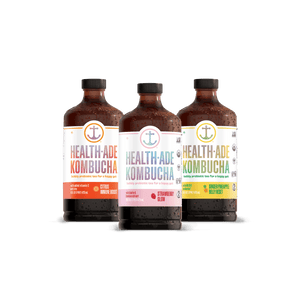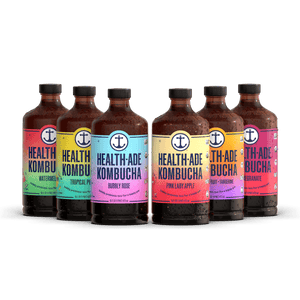
Kombucha | 12 Pack
Fan Favorite Variety Pack
One-time Purchase
49.95
Copied URL to clipboard!
The following is a guest post by Kate Gavlick, a nutritionist with a master’s degree in nutrition, peanut butter addict, writer, and photographer. You can find Kate's blog here.
Here’s an easy way to be a bit greener this Earth Day: start composting! Composting is a sustainable way to reduce food waste and produce healthy soil for your garden to grow flowers, fruits, vegetables, and herbs – a total win-win.
 There are a few basics to learn before starting your compost journey. First, you’ll need a compost bin, tumbler, or a citywide compost bin pickup.
There are a few basics to learn before starting your compost journey. First, you’ll need a compost bin, tumbler, or a citywide compost bin pickup.
For example, the city of Portland, OR provides green composting bins for organic scraps that are picked up weekly and taken to compost facilities – how cool is that?
Select a space for your compost bin. Outdoors, compost bins should be kept in a shady area, preferably away from the house – as they can get a bit stinky. Indoor composting is not recommended, unless it’s a small lidded bin that is picked up weekly or taken out to the larger compost bin outside.
Next, it’s important to know that each compost bin requires a balance of “green” organic materials and “brown” organic materials.
Green compost products include fresh and moist organic items including produce and food scraps, grass clippings, and garden clippings, all of which are all rich in nitrogen.
Brown organic materials include dry leaves, branches, and other dry materials, which are rich in carbon. Having a balance of nitrogen to carbon is essential to creating healthy compost, and a ratio of 30 parts green to 1 part brown is desired.
When adding material to your compost bin, make sure they’re adequately chopped up. Grinding and chopping organic materials (banana peels, beet greens, watermelon rinds, for example) helps to speed up the decomposing process.
Finally, make sure your compost pile is hydrated. This helps the microbes within the compost pile thrive, survive, and decompose organic materials. Water your compost pile every time you add more organic material, if possible.
Ready to compost? Here’s what you can throw in your pile.
 Things you can compost:
Things you can compost:
And a few things that you cannot compost:
Free Shipping on Orders over $75!
Subscription Orders Always Ship FREE No Matter What!
You're running on empty!
No sweat. Here are a few flavors you can never go wrong with.

Kombucha | 12 Pack
One-time Purchase
49.95

Glow Up Kombucha | 12 Pack
One-time Purchase
49.95

Kombucha | 6 Pack
One-time Purchase
31.95
